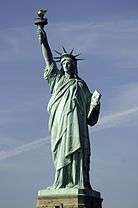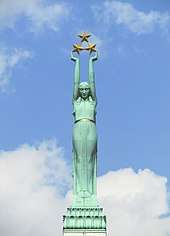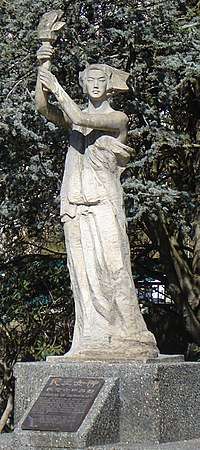Liberty (goddess)
Liberty is a loose term in English for the goddess or personification of the concept of liberty, and is represented by the Roman Goddess Libertas, by Marianne, the national symbol of France, and by many others.
The Statue of Liberty (Liberty Enlightening the World) by Frédéric Auguste Bartholdi is a well-known example in art, a gift from France to the United States.
Classical examples
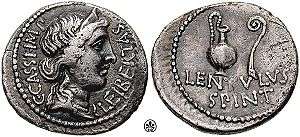
The ancient Roman goddess Libertas was honored during the second Punic War by a temple erected on the Aventine Hill in Rome by the father of Tiberius Gracchus. A statue in her honor also was raised by Clodius on the site of Marcus Tullius Cicero's house after it had been razed. The figure bears certain resemblances to Sol Invictus, the late Roman Republic sun deity and the crown often associated with that deity often appears in modern depictions of Liberty.
Neoclassical references
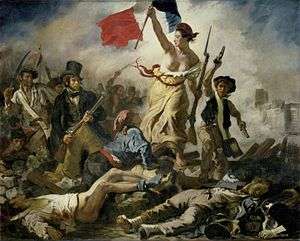
In 1793, during the French Revolution, the Notre Dame de Paris cathedral was turned into a "Temple of Reason" and, for a time, the Goddess of Liberty replaced the Virgin Mary on several altars.[1]
Depictions in the United States
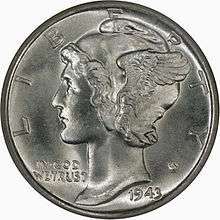
In the United States, "Liberty" often is depicted with five-pointed stars, as appear on the American flag, usually held in a raised hand. Another hand may hold a sword pointing downward. Depictions familiar to Americans include the following:
- The Statue of Liberty (Liberty Enlightening the World), its replicas, and its portrayal on many U.S. postage stamps.
- Many denominations of American coins have depicted Liberty in both bust side-view and full-figure designs; see also Liberty dollar, Seated Liberty dollar, Liberty dime, Indian Head cent, and others.
- The flags of the States of New York and New Jersey (along with various signs and government-owned items bearing the Seal of New Jersey)
- On the dome of the U.S. Capitol as Freedom
- On the dome of the Georgia State Capitol as Miss Freedom
- On the dome of the Texas State Capitol
- On the dome of the Allen County Courthouse in Fort Wayne, Indiana
- On the dome of the Bergen County Courthouse in Hackensack, New Jersey[2]
- On both Union and Confederate currency
In the early decades of the 20th Century, Liberty mostly displaced Columbia, who was widely used as the National personification of the US during the 19th Century.
See also
- Columbia (name)
- Great Seal of France
- Strengthen the Arm of Liberty
- Freedom Monument
- Goddess of Democracy
- Monument of Liberty (disambiguation)
- Statue of Liberty
- Seated Liberty dollar
- Liberty Head nickel
- Liberty Displaying the Arts and Sciences
- Liberty Leading the People
- George-Étienne Cartier Monument
References
- ↑ James A. Herrick, The Making of the New Spirituality, InterVarsity Press, 2004 ISBN 0-8308-3279-3, p. 75-76
- ↑ "Places We Call Home: Hackensack, N.J." FDU Magazine. Fall 2001. Retrieved 2008-11-04.
External links
| Wikimedia Commons has media related to Liberty (goddess). |
